Application of Data Architecture Model
VerifiedAdded on 2022/09/18
|9
|2537
|26
AI Summary
Contribute Materials
Your contribution can guide someone’s learning journey. Share your
documents today.
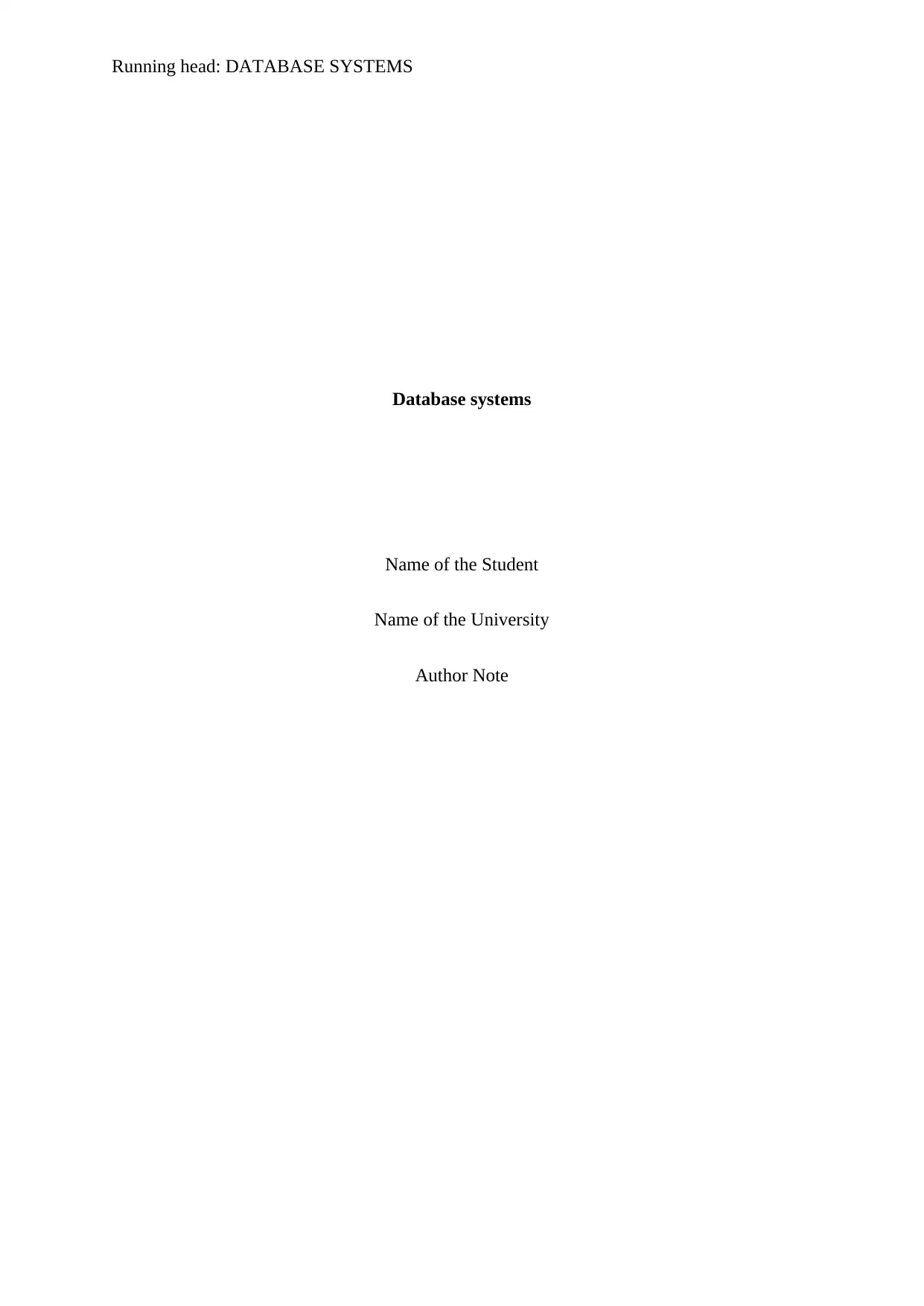
Running head: DATABASE SYSTEMS
Database systems
Name of the Student
Name of the University
Author Note
Database systems
Name of the Student
Name of the University
Author Note
Secure Best Marks with AI Grader
Need help grading? Try our AI Grader for instant feedback on your assignments.
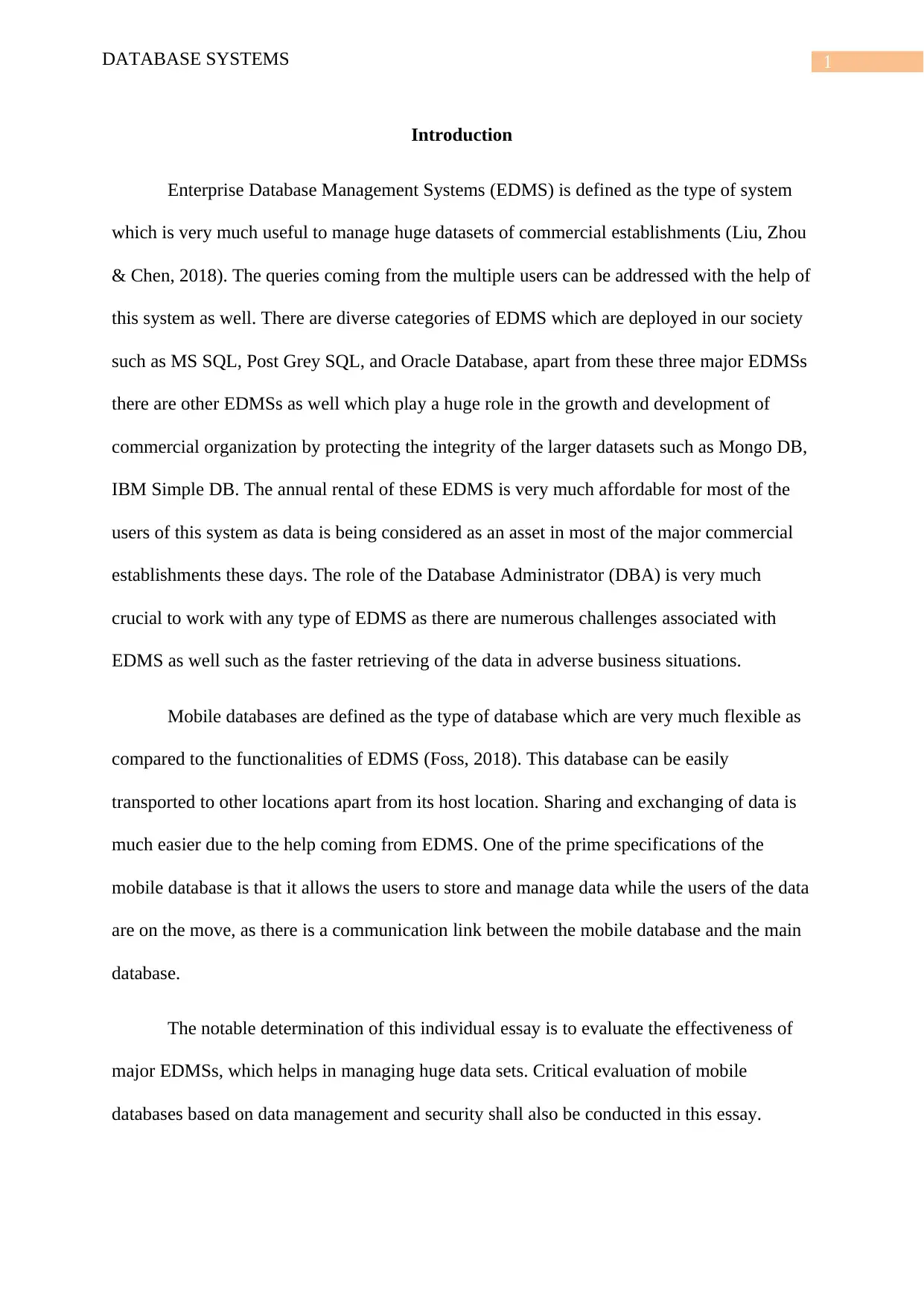
1DATABASE SYSTEMS
Introduction
Enterprise Database Management Systems (EDMS) is defined as the type of system
which is very much useful to manage huge datasets of commercial establishments (Liu, Zhou
& Chen, 2018). The queries coming from the multiple users can be addressed with the help of
this system as well. There are diverse categories of EDMS which are deployed in our society
such as MS SQL, Post Grey SQL, and Oracle Database, apart from these three major EDMSs
there are other EDMSs as well which play a huge role in the growth and development of
commercial organization by protecting the integrity of the larger datasets such as Mongo DB,
IBM Simple DB. The annual rental of these EDMS is very much affordable for most of the
users of this system as data is being considered as an asset in most of the major commercial
establishments these days. The role of the Database Administrator (DBA) is very much
crucial to work with any type of EDMS as there are numerous challenges associated with
EDMS as well such as the faster retrieving of the data in adverse business situations.
Mobile databases are defined as the type of database which are very much flexible as
compared to the functionalities of EDMS (Foss, 2018). This database can be easily
transported to other locations apart from its host location. Sharing and exchanging of data is
much easier due to the help coming from EDMS. One of the prime specifications of the
mobile database is that it allows the users to store and manage data while the users of the data
are on the move, as there is a communication link between the mobile database and the main
database.
The notable determination of this individual essay is to evaluate the effectiveness of
major EDMSs, which helps in managing huge data sets. Critical evaluation of mobile
databases based on data management and security shall also be conducted in this essay.
Introduction
Enterprise Database Management Systems (EDMS) is defined as the type of system
which is very much useful to manage huge datasets of commercial establishments (Liu, Zhou
& Chen, 2018). The queries coming from the multiple users can be addressed with the help of
this system as well. There are diverse categories of EDMS which are deployed in our society
such as MS SQL, Post Grey SQL, and Oracle Database, apart from these three major EDMSs
there are other EDMSs as well which play a huge role in the growth and development of
commercial organization by protecting the integrity of the larger datasets such as Mongo DB,
IBM Simple DB. The annual rental of these EDMS is very much affordable for most of the
users of this system as data is being considered as an asset in most of the major commercial
establishments these days. The role of the Database Administrator (DBA) is very much
crucial to work with any type of EDMS as there are numerous challenges associated with
EDMS as well such as the faster retrieving of the data in adverse business situations.
Mobile databases are defined as the type of database which are very much flexible as
compared to the functionalities of EDMS (Foss, 2018). This database can be easily
transported to other locations apart from its host location. Sharing and exchanging of data is
much easier due to the help coming from EDMS. One of the prime specifications of the
mobile database is that it allows the users to store and manage data while the users of the data
are on the move, as there is a communication link between the mobile database and the main
database.
The notable determination of this individual essay is to evaluate the effectiveness of
major EDMSs, which helps in managing huge data sets. Critical evaluation of mobile
databases based on data management and security shall also be conducted in this essay.

2DATABASE SYSTEMS
Categories of functions in EDMS
There are diverse categories of functions which are related to the EDMS such as data
dictionary, database communication interfaces, data storage management, data
transformation, security management, multi-user access control, data integrity management,
and database access languages (Macyna & Kukowski, 2019). Each of these functions is very
much useful for the effective function of EDMS.
Data Dictionary
Data elements and their relationships ate stored in the data dictionary, as a result, it is
one of the most significant functions of EDMS (Nuessle & Kennedy, 2019). The data
components and the structure of the data can be analysed from the data dictionary, at the
same time this function is also very much useful to manage ay type of changes in the
structure of the database.
Data storage management
Reporting of the data is conducted from this function of EDMS, this function is also
very much responsible for validating the data which are stored in EDMS (Bittner, 2017). The
procedural code of EDMS can be verified in the first place with the help of this function as
well. The orientation of the different type of data which are stored in the EDMS can be
identified by the DBA from this function as well.
Data transformation
The raw data which are provided to the EDMS is converted to data structures using
this function (Lu & Holubová, 2017). The function is also very much useful to distinguish the
physical data and the logical data, as the categorization of the data is one of the prime
Categories of functions in EDMS
There are diverse categories of functions which are related to the EDMS such as data
dictionary, database communication interfaces, data storage management, data
transformation, security management, multi-user access control, data integrity management,
and database access languages (Macyna & Kukowski, 2019). Each of these functions is very
much useful for the effective function of EDMS.
Data Dictionary
Data elements and their relationships ate stored in the data dictionary, as a result, it is
one of the most significant functions of EDMS (Nuessle & Kennedy, 2019). The data
components and the structure of the data can be analysed from the data dictionary, at the
same time this function is also very much useful to manage ay type of changes in the
structure of the database.
Data storage management
Reporting of the data is conducted from this function of EDMS, this function is also
very much responsible for validating the data which are stored in EDMS (Bittner, 2017). The
procedural code of EDMS can be verified in the first place with the help of this function as
well. The orientation of the different type of data which are stored in the EDMS can be
identified by the DBA from this function as well.
Data transformation
The raw data which are provided to the EDMS is converted to data structures using
this function (Lu & Holubová, 2017). The function is also very much useful to distinguish the
physical data and the logical data, as the categorization of the data is one of the prime
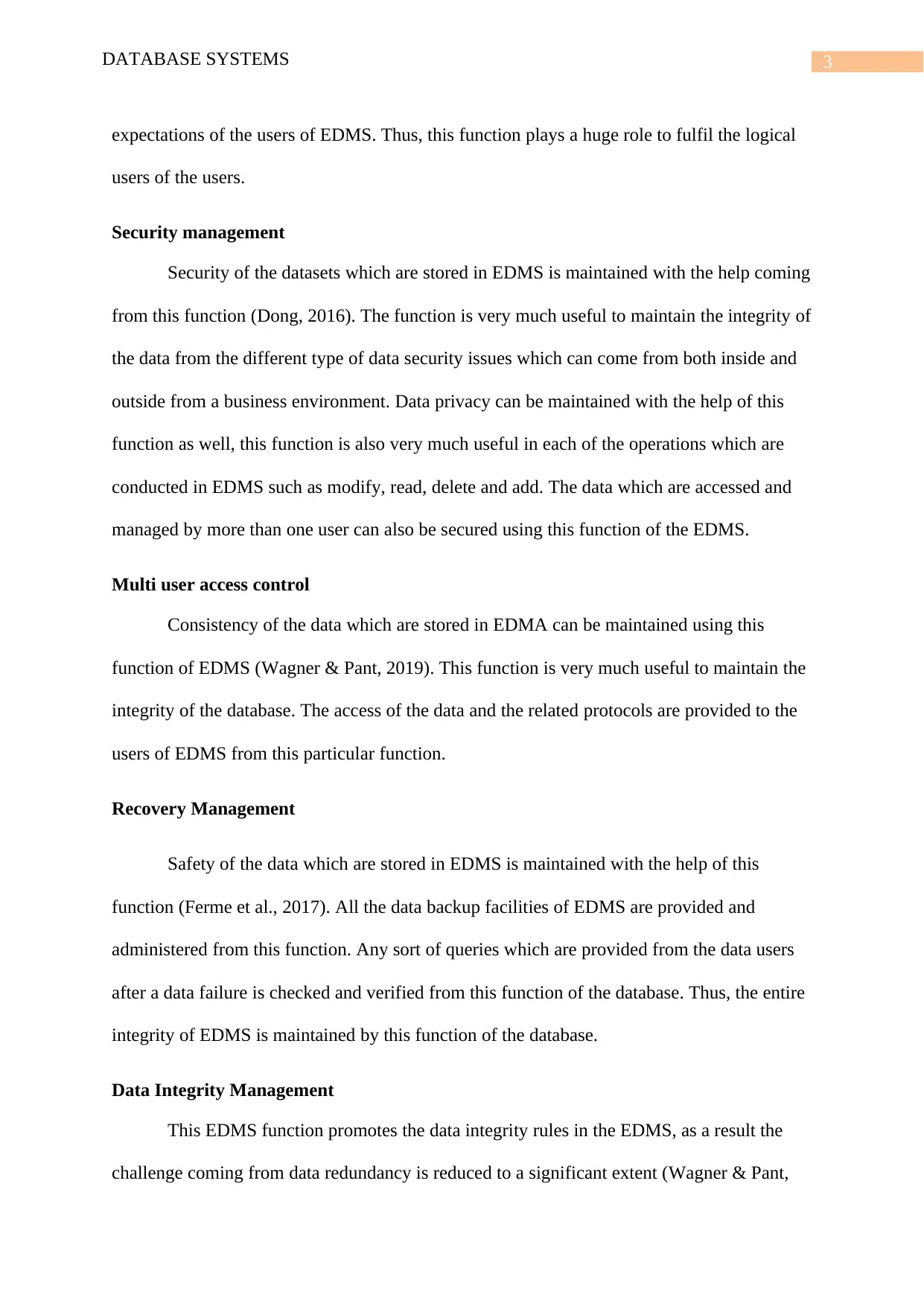
3DATABASE SYSTEMS
expectations of the users of EDMS. Thus, this function plays a huge role to fulfil the logical
users of the users.
Security management
Security of the datasets which are stored in EDMS is maintained with the help coming
from this function (Dong, 2016). The function is very much useful to maintain the integrity of
the data from the different type of data security issues which can come from both inside and
outside from a business environment. Data privacy can be maintained with the help of this
function as well, this function is also very much useful in each of the operations which are
conducted in EDMS such as modify, read, delete and add. The data which are accessed and
managed by more than one user can also be secured using this function of the EDMS.
Multi user access control
Consistency of the data which are stored in EDMA can be maintained using this
function of EDMS (Wagner & Pant, 2019). This function is very much useful to maintain the
integrity of the database. The access of the data and the related protocols are provided to the
users of EDMS from this particular function.
Recovery Management
Safety of the data which are stored in EDMS is maintained with the help of this
function (Ferme et al., 2017). All the data backup facilities of EDMS are provided and
administered from this function. Any sort of queries which are provided from the data users
after a data failure is checked and verified from this function of the database. Thus, the entire
integrity of EDMS is maintained by this function of the database.
Data Integrity Management
This EDMS function promotes the data integrity rules in the EDMS, as a result the
challenge coming from data redundancy is reduced to a significant extent (Wagner & Pant,
expectations of the users of EDMS. Thus, this function plays a huge role to fulfil the logical
users of the users.
Security management
Security of the datasets which are stored in EDMS is maintained with the help coming
from this function (Dong, 2016). The function is very much useful to maintain the integrity of
the data from the different type of data security issues which can come from both inside and
outside from a business environment. Data privacy can be maintained with the help of this
function as well, this function is also very much useful in each of the operations which are
conducted in EDMS such as modify, read, delete and add. The data which are accessed and
managed by more than one user can also be secured using this function of the EDMS.
Multi user access control
Consistency of the data which are stored in EDMA can be maintained using this
function of EDMS (Wagner & Pant, 2019). This function is very much useful to maintain the
integrity of the database. The access of the data and the related protocols are provided to the
users of EDMS from this particular function.
Recovery Management
Safety of the data which are stored in EDMS is maintained with the help of this
function (Ferme et al., 2017). All the data backup facilities of EDMS are provided and
administered from this function. Any sort of queries which are provided from the data users
after a data failure is checked and verified from this function of the database. Thus, the entire
integrity of EDMS is maintained by this function of the database.
Data Integrity Management
This EDMS function promotes the data integrity rules in the EDMS, as a result the
challenge coming from data redundancy is reduced to a significant extent (Wagner & Pant,
Secure Best Marks with AI Grader
Need help grading? Try our AI Grader for instant feedback on your assignments.
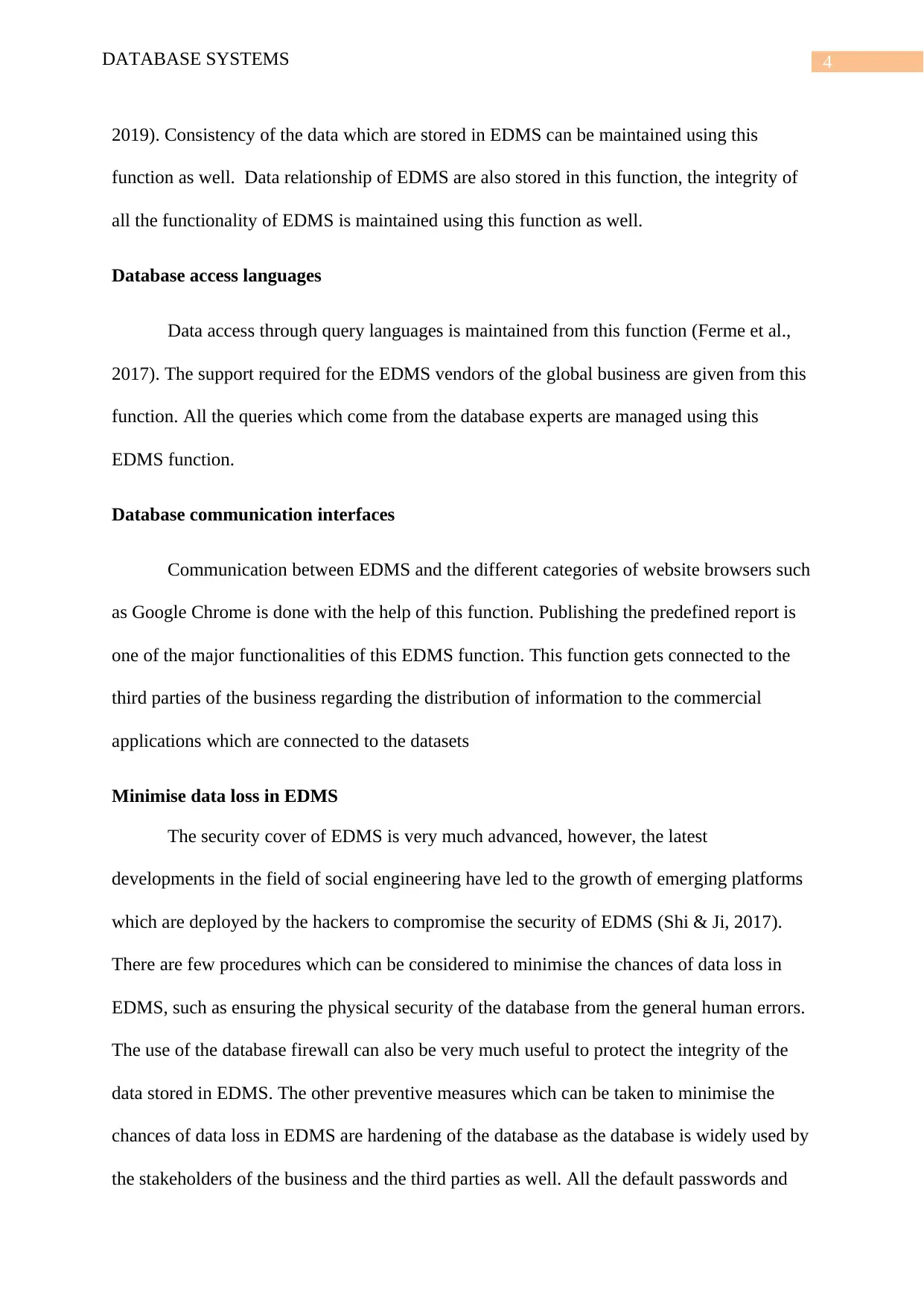
4DATABASE SYSTEMS
2019). Consistency of the data which are stored in EDMS can be maintained using this
function as well. Data relationship of EDMS are also stored in this function, the integrity of
all the functionality of EDMS is maintained using this function as well.
Database access languages
Data access through query languages is maintained from this function (Ferme et al.,
2017). The support required for the EDMS vendors of the global business are given from this
function. All the queries which come from the database experts are managed using this
EDMS function.
Database communication interfaces
Communication between EDMS and the different categories of website browsers such
as Google Chrome is done with the help of this function. Publishing the predefined report is
one of the major functionalities of this EDMS function. This function gets connected to the
third parties of the business regarding the distribution of information to the commercial
applications which are connected to the datasets
Minimise data loss in EDMS
The security cover of EDMS is very much advanced, however, the latest
developments in the field of social engineering have led to the growth of emerging platforms
which are deployed by the hackers to compromise the security of EDMS (Shi & Ji, 2017).
There are few procedures which can be considered to minimise the chances of data loss in
EDMS, such as ensuring the physical security of the database from the general human errors.
The use of the database firewall can also be very much useful to protect the integrity of the
data stored in EDMS. The other preventive measures which can be taken to minimise the
chances of data loss in EDMS are hardening of the database as the database is widely used by
the stakeholders of the business and the third parties as well. All the default passwords and
2019). Consistency of the data which are stored in EDMS can be maintained using this
function as well. Data relationship of EDMS are also stored in this function, the integrity of
all the functionality of EDMS is maintained using this function as well.
Database access languages
Data access through query languages is maintained from this function (Ferme et al.,
2017). The support required for the EDMS vendors of the global business are given from this
function. All the queries which come from the database experts are managed using this
EDMS function.
Database communication interfaces
Communication between EDMS and the different categories of website browsers such
as Google Chrome is done with the help of this function. Publishing the predefined report is
one of the major functionalities of this EDMS function. This function gets connected to the
third parties of the business regarding the distribution of information to the commercial
applications which are connected to the datasets
Minimise data loss in EDMS
The security cover of EDMS is very much advanced, however, the latest
developments in the field of social engineering have led to the growth of emerging platforms
which are deployed by the hackers to compromise the security of EDMS (Shi & Ji, 2017).
There are few procedures which can be considered to minimise the chances of data loss in
EDMS, such as ensuring the physical security of the database from the general human errors.
The use of the database firewall can also be very much useful to protect the integrity of the
data stored in EDMS. The other preventive measures which can be taken to minimise the
chances of data loss in EDMS are hardening of the database as the database is widely used by
the stakeholders of the business and the third parties as well. All the default passwords and
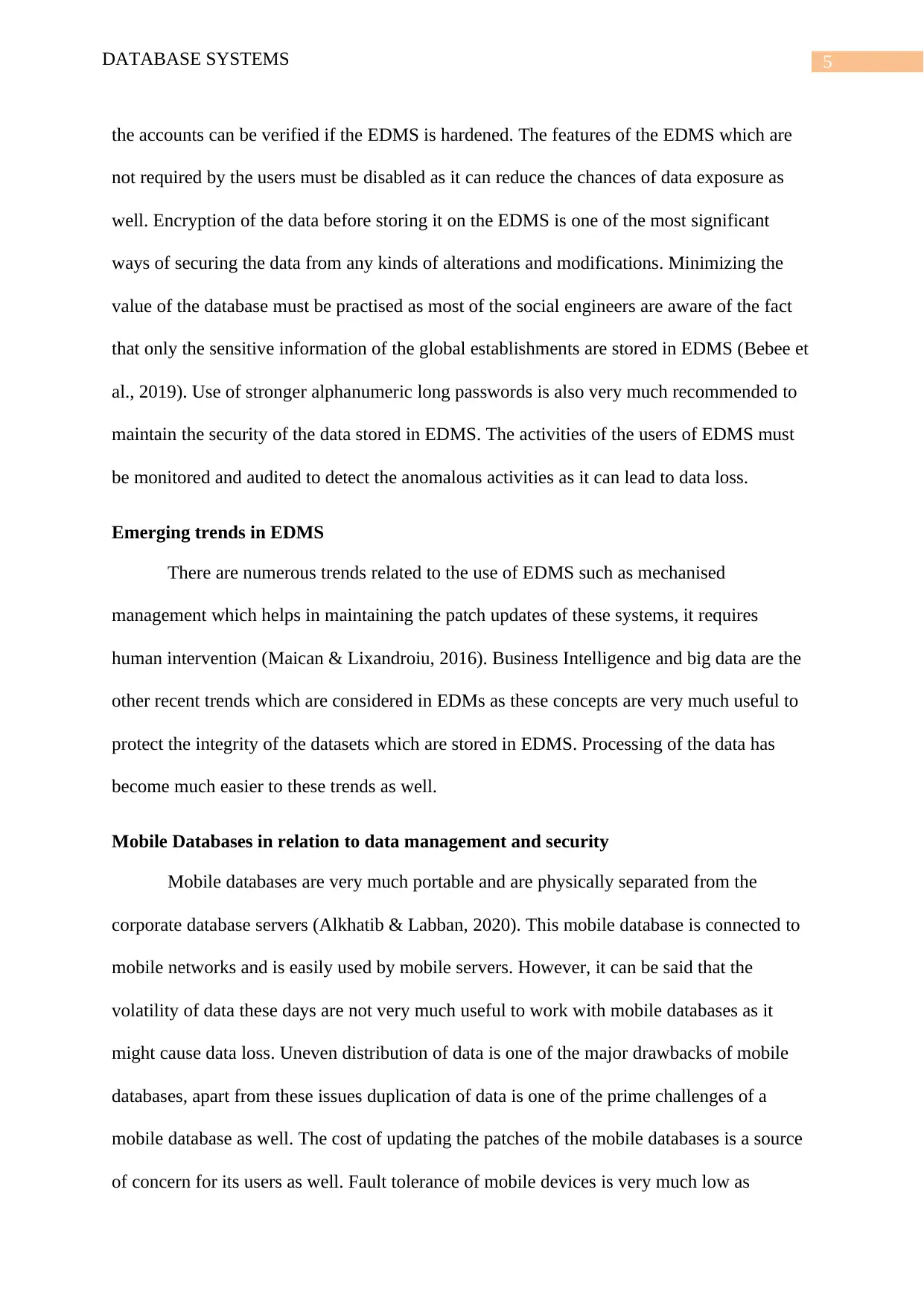
5DATABASE SYSTEMS
the accounts can be verified if the EDMS is hardened. The features of the EDMS which are
not required by the users must be disabled as it can reduce the chances of data exposure as
well. Encryption of the data before storing it on the EDMS is one of the most significant
ways of securing the data from any kinds of alterations and modifications. Minimizing the
value of the database must be practised as most of the social engineers are aware of the fact
that only the sensitive information of the global establishments are stored in EDMS (Bebee et
al., 2019). Use of stronger alphanumeric long passwords is also very much recommended to
maintain the security of the data stored in EDMS. The activities of the users of EDMS must
be monitored and audited to detect the anomalous activities as it can lead to data loss.
Emerging trends in EDMS
There are numerous trends related to the use of EDMS such as mechanised
management which helps in maintaining the patch updates of these systems, it requires
human intervention (Maican & Lixandroiu, 2016). Business Intelligence and big data are the
other recent trends which are considered in EDMs as these concepts are very much useful to
protect the integrity of the datasets which are stored in EDMS. Processing of the data has
become much easier to these trends as well.
Mobile Databases in relation to data management and security
Mobile databases are very much portable and are physically separated from the
corporate database servers (Alkhatib & Labban, 2020). This mobile database is connected to
mobile networks and is easily used by mobile servers. However, it can be said that the
volatility of data these days are not very much useful to work with mobile databases as it
might cause data loss. Uneven distribution of data is one of the major drawbacks of mobile
databases, apart from these issues duplication of data is one of the prime challenges of a
mobile database as well. The cost of updating the patches of the mobile databases is a source
of concern for its users as well. Fault tolerance of mobile devices is very much low as
the accounts can be verified if the EDMS is hardened. The features of the EDMS which are
not required by the users must be disabled as it can reduce the chances of data exposure as
well. Encryption of the data before storing it on the EDMS is one of the most significant
ways of securing the data from any kinds of alterations and modifications. Minimizing the
value of the database must be practised as most of the social engineers are aware of the fact
that only the sensitive information of the global establishments are stored in EDMS (Bebee et
al., 2019). Use of stronger alphanumeric long passwords is also very much recommended to
maintain the security of the data stored in EDMS. The activities of the users of EDMS must
be monitored and audited to detect the anomalous activities as it can lead to data loss.
Emerging trends in EDMS
There are numerous trends related to the use of EDMS such as mechanised
management which helps in maintaining the patch updates of these systems, it requires
human intervention (Maican & Lixandroiu, 2016). Business Intelligence and big data are the
other recent trends which are considered in EDMs as these concepts are very much useful to
protect the integrity of the datasets which are stored in EDMS. Processing of the data has
become much easier to these trends as well.
Mobile Databases in relation to data management and security
Mobile databases are very much portable and are physically separated from the
corporate database servers (Alkhatib & Labban, 2020). This mobile database is connected to
mobile networks and is easily used by mobile servers. However, it can be said that the
volatility of data these days are not very much useful to work with mobile databases as it
might cause data loss. Uneven distribution of data is one of the major drawbacks of mobile
databases, apart from these issues duplication of data is one of the prime challenges of a
mobile database as well. The cost of updating the patches of the mobile databases is a source
of concern for its users as well. Fault tolerance of mobile devices is very much low as
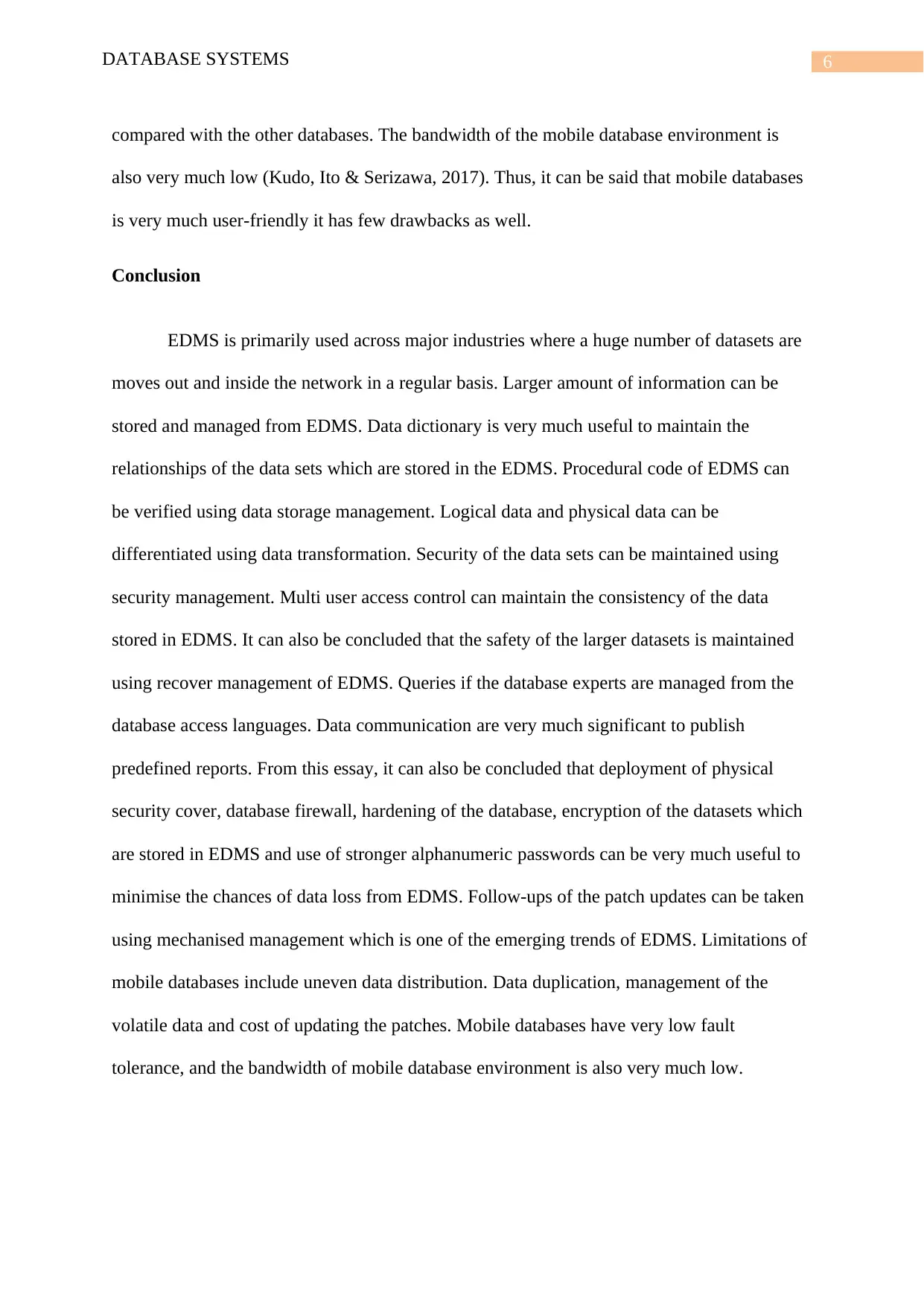
6DATABASE SYSTEMS
compared with the other databases. The bandwidth of the mobile database environment is
also very much low (Kudo, Ito & Serizawa, 2017). Thus, it can be said that mobile databases
is very much user-friendly it has few drawbacks as well.
Conclusion
EDMS is primarily used across major industries where a huge number of datasets are
moves out and inside the network in a regular basis. Larger amount of information can be
stored and managed from EDMS. Data dictionary is very much useful to maintain the
relationships of the data sets which are stored in the EDMS. Procedural code of EDMS can
be verified using data storage management. Logical data and physical data can be
differentiated using data transformation. Security of the data sets can be maintained using
security management. Multi user access control can maintain the consistency of the data
stored in EDMS. It can also be concluded that the safety of the larger datasets is maintained
using recover management of EDMS. Queries if the database experts are managed from the
database access languages. Data communication are very much significant to publish
predefined reports. From this essay, it can also be concluded that deployment of physical
security cover, database firewall, hardening of the database, encryption of the datasets which
are stored in EDMS and use of stronger alphanumeric passwords can be very much useful to
minimise the chances of data loss from EDMS. Follow-ups of the patch updates can be taken
using mechanised management which is one of the emerging trends of EDMS. Limitations of
mobile databases include uneven data distribution. Data duplication, management of the
volatile data and cost of updating the patches. Mobile databases have very low fault
tolerance, and the bandwidth of mobile database environment is also very much low.
compared with the other databases. The bandwidth of the mobile database environment is
also very much low (Kudo, Ito & Serizawa, 2017). Thus, it can be said that mobile databases
is very much user-friendly it has few drawbacks as well.
Conclusion
EDMS is primarily used across major industries where a huge number of datasets are
moves out and inside the network in a regular basis. Larger amount of information can be
stored and managed from EDMS. Data dictionary is very much useful to maintain the
relationships of the data sets which are stored in the EDMS. Procedural code of EDMS can
be verified using data storage management. Logical data and physical data can be
differentiated using data transformation. Security of the data sets can be maintained using
security management. Multi user access control can maintain the consistency of the data
stored in EDMS. It can also be concluded that the safety of the larger datasets is maintained
using recover management of EDMS. Queries if the database experts are managed from the
database access languages. Data communication are very much significant to publish
predefined reports. From this essay, it can also be concluded that deployment of physical
security cover, database firewall, hardening of the database, encryption of the datasets which
are stored in EDMS and use of stronger alphanumeric passwords can be very much useful to
minimise the chances of data loss from EDMS. Follow-ups of the patch updates can be taken
using mechanised management which is one of the emerging trends of EDMS. Limitations of
mobile databases include uneven data distribution. Data duplication, management of the
volatile data and cost of updating the patches. Mobile databases have very low fault
tolerance, and the bandwidth of mobile database environment is also very much low.
Paraphrase This Document
Need a fresh take? Get an instant paraphrase of this document with our AI Paraphraser
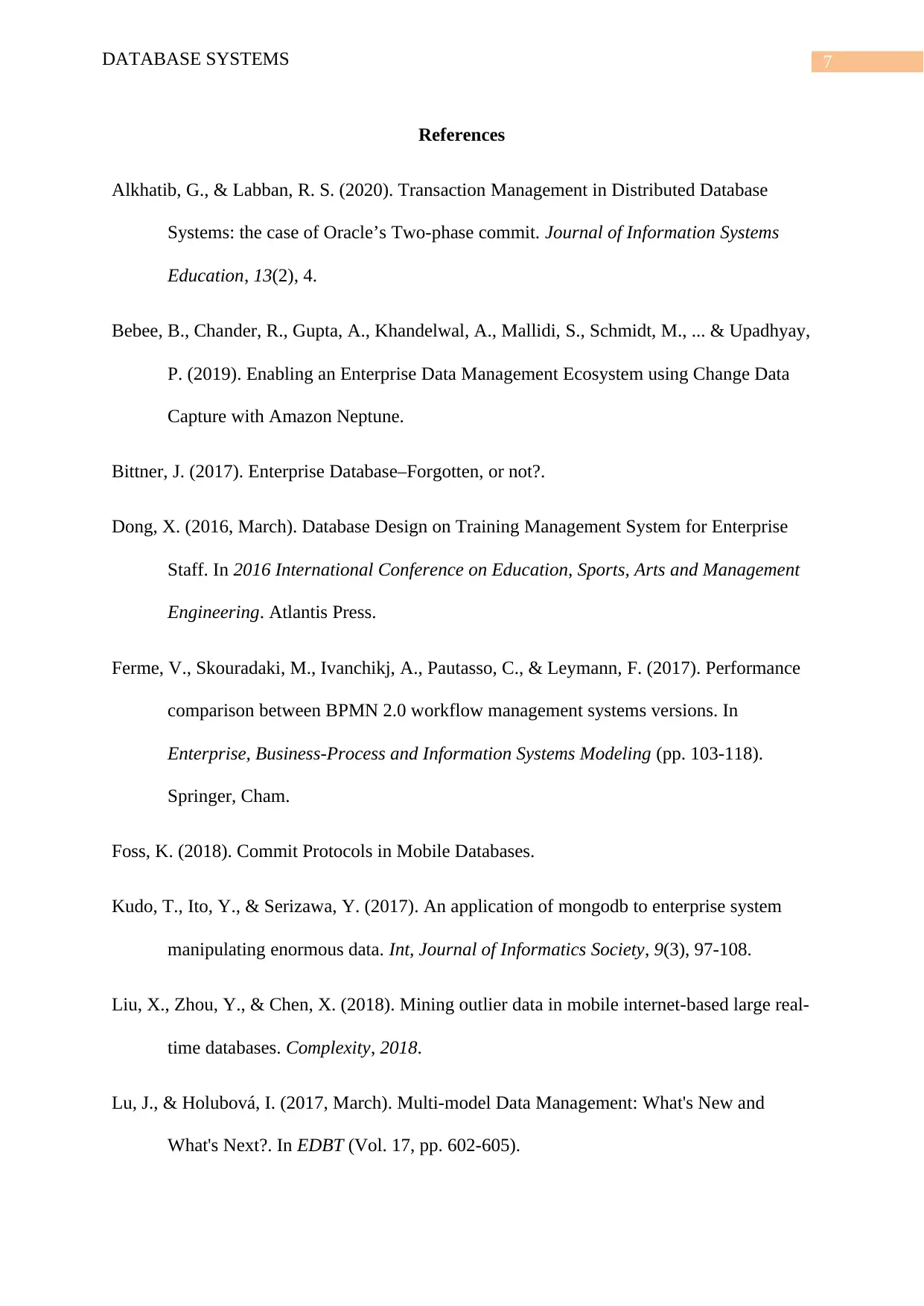
7DATABASE SYSTEMS
References
Alkhatib, G., & Labban, R. S. (2020). Transaction Management in Distributed Database
Systems: the case of Oracle’s Two-phase commit. Journal of Information Systems
Education, 13(2), 4.
Bebee, B., Chander, R., Gupta, A., Khandelwal, A., Mallidi, S., Schmidt, M., ... & Upadhyay,
P. (2019). Enabling an Enterprise Data Management Ecosystem using Change Data
Capture with Amazon Neptune.
Bittner, J. (2017). Enterprise Database–Forgotten, or not?.
Dong, X. (2016, March). Database Design on Training Management System for Enterprise
Staff. In 2016 International Conference on Education, Sports, Arts and Management
Engineering. Atlantis Press.
Ferme, V., Skouradaki, M., Ivanchikj, A., Pautasso, C., & Leymann, F. (2017). Performance
comparison between BPMN 2.0 workflow management systems versions. In
Enterprise, Business-Process and Information Systems Modeling (pp. 103-118).
Springer, Cham.
Foss, K. (2018). Commit Protocols in Mobile Databases.
Kudo, T., Ito, Y., & Serizawa, Y. (2017). An application of mongodb to enterprise system
manipulating enormous data. Int, Journal of Informatics Society, 9(3), 97-108.
Liu, X., Zhou, Y., & Chen, X. (2018). Mining outlier data in mobile internet-based large real-
time databases. Complexity, 2018.
Lu, J., & Holubová, I. (2017, March). Multi-model Data Management: What's New and
What's Next?. In EDBT (Vol. 17, pp. 602-605).
References
Alkhatib, G., & Labban, R. S. (2020). Transaction Management in Distributed Database
Systems: the case of Oracle’s Two-phase commit. Journal of Information Systems
Education, 13(2), 4.
Bebee, B., Chander, R., Gupta, A., Khandelwal, A., Mallidi, S., Schmidt, M., ... & Upadhyay,
P. (2019). Enabling an Enterprise Data Management Ecosystem using Change Data
Capture with Amazon Neptune.
Bittner, J. (2017). Enterprise Database–Forgotten, or not?.
Dong, X. (2016, March). Database Design on Training Management System for Enterprise
Staff. In 2016 International Conference on Education, Sports, Arts and Management
Engineering. Atlantis Press.
Ferme, V., Skouradaki, M., Ivanchikj, A., Pautasso, C., & Leymann, F. (2017). Performance
comparison between BPMN 2.0 workflow management systems versions. In
Enterprise, Business-Process and Information Systems Modeling (pp. 103-118).
Springer, Cham.
Foss, K. (2018). Commit Protocols in Mobile Databases.
Kudo, T., Ito, Y., & Serizawa, Y. (2017). An application of mongodb to enterprise system
manipulating enormous data. Int, Journal of Informatics Society, 9(3), 97-108.
Liu, X., Zhou, Y., & Chen, X. (2018). Mining outlier data in mobile internet-based large real-
time databases. Complexity, 2018.
Lu, J., & Holubová, I. (2017, March). Multi-model Data Management: What's New and
What's Next?. In EDBT (Vol. 17, pp. 602-605).
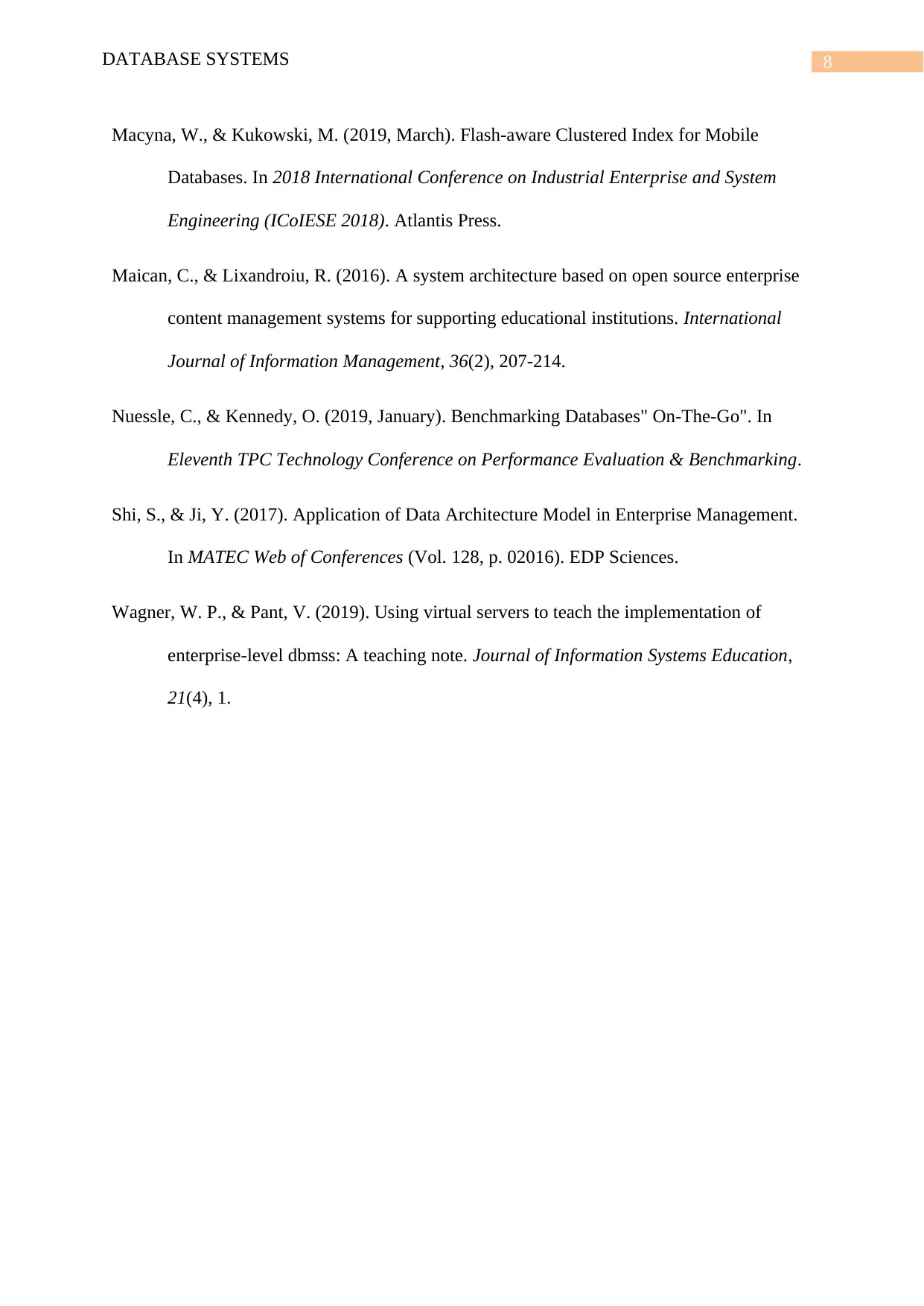
8DATABASE SYSTEMS
Macyna, W., & Kukowski, M. (2019, March). Flash-aware Clustered Index for Mobile
Databases. In 2018 International Conference on Industrial Enterprise and System
Engineering (ICoIESE 2018). Atlantis Press.
Maican, C., & Lixandroiu, R. (2016). A system architecture based on open source enterprise
content management systems for supporting educational institutions. International
Journal of Information Management, 36(2), 207-214.
Nuessle, C., & Kennedy, O. (2019, January). Benchmarking Databases" On-The-Go". In
Eleventh TPC Technology Conference on Performance Evaluation & Benchmarking.
Shi, S., & Ji, Y. (2017). Application of Data Architecture Model in Enterprise Management.
In MATEC Web of Conferences (Vol. 128, p. 02016). EDP Sciences.
Wagner, W. P., & Pant, V. (2019). Using virtual servers to teach the implementation of
enterprise-level dbmss: A teaching note. Journal of Information Systems Education,
21(4), 1.
Macyna, W., & Kukowski, M. (2019, March). Flash-aware Clustered Index for Mobile
Databases. In 2018 International Conference on Industrial Enterprise and System
Engineering (ICoIESE 2018). Atlantis Press.
Maican, C., & Lixandroiu, R. (2016). A system architecture based on open source enterprise
content management systems for supporting educational institutions. International
Journal of Information Management, 36(2), 207-214.
Nuessle, C., & Kennedy, O. (2019, January). Benchmarking Databases" On-The-Go". In
Eleventh TPC Technology Conference on Performance Evaluation & Benchmarking.
Shi, S., & Ji, Y. (2017). Application of Data Architecture Model in Enterprise Management.
In MATEC Web of Conferences (Vol. 128, p. 02016). EDP Sciences.
Wagner, W. P., & Pant, V. (2019). Using virtual servers to teach the implementation of
enterprise-level dbmss: A teaching note. Journal of Information Systems Education,
21(4), 1.
1 out of 9
Related Documents
Your All-in-One AI-Powered Toolkit for Academic Success.
+13062052269
info@desklib.com
Available 24*7 on WhatsApp / Email
![[object Object]](/_next/static/media/star-bottom.7253800d.svg)
Unlock your academic potential
© 2024 | Zucol Services PVT LTD | All rights reserved.





